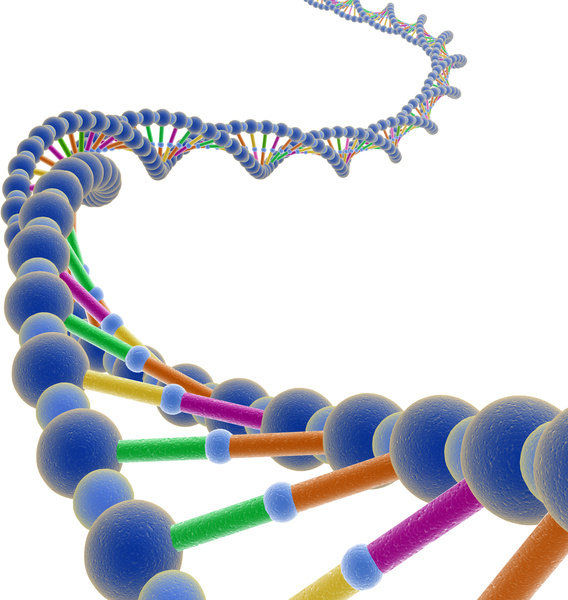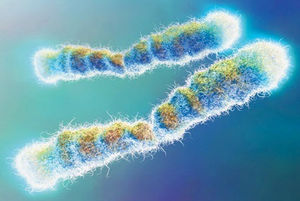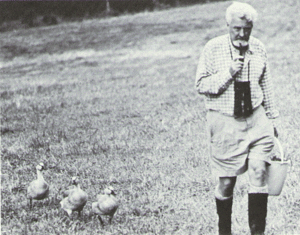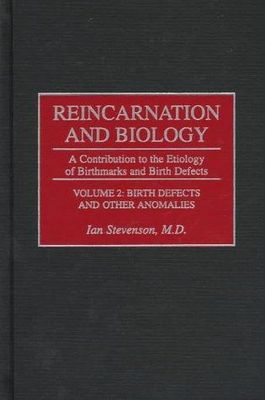 The reader should probably be getting the idea by now: the approach SOTT.net takes to the Cassiopaean Experiment really is a case of 10% inspiration, 90% perspiration. One question asked, or one answer given, is often enough to inspire a whole line of research leading to data and conclusions that might only be tangentially related to the original question. That’s the whole point: discovery, and in that sense, the data in the Cs transmissions is more like the thread of Ariadne than a book of ‘Divine Revelation’. The clues given lead those interested to take up the search through a vast labyrinth of information and ‘disinformation’ to what I like to think of as the heart of the matter: those areas of study that are not only highly relevant to coming to an understanding of the human condition and the nature of the cosmos, but which are also closely interrelated and always seemingly one step beyond what is currently accepted as ‘common knowledge’. In other words, one mystery reveals another, then another. It’s a never-ending journey of discovery, which is what I think lies at the heart of science and mysticism. Anything else, like the belief that ‘we finally know all there is to know on this subject’, only leads to intellectual stagnation and the death of curiosity. As we like to say around here, there’s no such thing as free lunch… nor infallible texts.
The reader should probably be getting the idea by now: the approach SOTT.net takes to the Cassiopaean Experiment really is a case of 10% inspiration, 90% perspiration. One question asked, or one answer given, is often enough to inspire a whole line of research leading to data and conclusions that might only be tangentially related to the original question. That’s the whole point: discovery, and in that sense, the data in the Cs transmissions is more like the thread of Ariadne than a book of ‘Divine Revelation’. The clues given lead those interested to take up the search through a vast labyrinth of information and ‘disinformation’ to what I like to think of as the heart of the matter: those areas of study that are not only highly relevant to coming to an understanding of the human condition and the nature of the cosmos, but which are also closely interrelated and always seemingly one step beyond what is currently accepted as ‘common knowledge’. In other words, one mystery reveals another, then another. It’s a never-ending journey of discovery, which is what I think lies at the heart of science and mysticism. Anything else, like the belief that ‘we finally know all there is to know on this subject’, only leads to intellectual stagnation and the death of curiosity. As we like to say around here, there’s no such thing as free lunch… nor infallible texts.
For those curious to know, the research inspired by the Cs experiment has led the SOTT team to many of the topics that we focus on. Without them, and the life experiences that we surely wouldn’t have had if not engaged in this project, we probably never would have learned what we have about the history and danger of cometary catastrophe, the electrical nature of the universe, psychopathy, ponerology, polyvagal theory, and separating the wheat from the chaff when it comes to the vast number of ‘conspiracy theories’ on the market. Or at least, it would have taken us a lot longer. After all, all of these fields have their respective authorities and advocates, those scientific mavericks who have come to the conclusion all was not right in their particular field of study, whether in history, politics, psychology, ufology, astrophysics, meteorology, or any other science. But this is usually done on their own, disconnected from the bigger picture and how to tie it all together. Often a lifetime of research will go into this process, with the downside that other possible areas of research are left untouched. (Witness researchers into the paranormal who deride ‘conspiracy theories’, or ‘9/11 conspiracy theorists’ who deride ufologists.) But we try to bring as many of them as possible together, to give as comprehensive as possible a view of reality as we can. One of these areas, the one I’ll deal with below, has to do with genetics, and the possibilities inherent in that mysterious building block of life: DNA.
One Person’s Junk…
Considering that the structure of DNA was only discovered close to 60 years ago, it’s no surprise we have yet to solve all of its mysteries. It has only been in the last 30 years or so that the function of epigenetics (heritable changes in gene expression) has been better understood, and the possible implications and applications of that field are enormous. Then there’s the human genome, which was only cracked 10 years ago, revealing a surprisingly piddling 35,000 genes or so. But genes only make up a tiny percentage of our DNA. Considering that the sole function of DNA was long thought to simply code for the proteins that make up our physical structure, the question has puzzled scientists for years. ‘Junk’ DNA was the term invented in the 1970s for the long portions of non-coding DNA with no known function, amounting to about 98% of the human genome. Nowadays, it’s known that at least some of this DNA does serve a regulatory function, while other portions continue to remain mysterious. On 23 September 2000, Laura asked the Cs about this ‘junk’:
Q: You once said [26 November 1994] that the core of DNA is an as yet undiscovered enzyme related to carbon. Is that correct?
A: Yes.
Q: Here in this book it says: “Evidence is accumulating that only a relatively small portion of the DNA sequence is for so-called structural genes. Structural genes lead to the production of protein. There are an estimated 50,000 structural genes with an average size of approximately 5,000 base pairs, which then accounts for only 250 million of the estimated 3 billion base pairs. What is the rest of the DNA for? Some of the DNA is so-called repetitive sequences, repeated thousands of times. The function is unknown. The ALU repeat, for instance, contains over 300,000 copies of the same 300 base pair sequence. Certainly this DNA is not junk and plays some important role in the gene regulation chromosomal architecture or chromosomal replication. Until 1977, it was thought that genes were single sequences of DNA that are coded into RNA and then into protein. However, further study has shown greater complexity. It is now known that there are pieces of DNA within a gene that are not translated into protein. These intervening sequences, or INTRONS, are somewhat of a mystery, but appear to be a very common phenomenon.” Now, is this thing they are talking about, these introns, are these the core that you were talking about?
Introns are sequences of non-coding DNA found interspersed between the genes of all eukaryotes. (© Pharmapolis.net)
A: In part.
Q: What about this ALU repeat with over 300,000 copies of the same base pair sequence. What is it?
A: Tribal unit.
Q: What is a tribal unit?
A: Sectionalized zone of significant marker compounds.
Q: What does this code for?
A: Physiological/spiritual union profile.
First of all, until ribozymes (RNA molecules with the ability to catalyze chemical reactions) were discovered in the 1980s, scientists thought that only enzymes could act as biological catalysts. But the ability of certain RNA molecules to do so makes evolutionary sense. (That is, what came first? The RNA to produce the enzyme, or the enzyme to catalyze the reactions?) These ribozymes were discovered on an RNA intron. Their DNA cousins, deoxyribozymes (or DNAzymes) were only discovered in 1994, with research published in December of that year, just after the session alluded to above. But because of DNA’s lack of specific functional groups for similar reactions and its stable double-helix structure, DNAzymes have to be created in a lab – they have yet to be found ‘in nature’ – and even then, they only function when interacting with single-stranded DNA. But given the ease with which they are created and are able to catalyze reactions, perhaps the DNA ‘core’ referred to above is a naturally occurring deoxyribozyme? As Yingfu Li and Ronald Breaker, authors of a 1999 review of research on the subject, write:
Unfortunately, single-stranded structures are only rarely sampled in nature, during such cellular processes as DNA replication, DNA repair and gene expression. It is not surprising then that DNA has not been found to serve any role in biological catalysis. … Several fundamental issues concerning DNA function remain to be investigated more thoroughly in order to decide whether DNA truly is the inert molecule that we have thought it to be or whether DNA can aspire to the catalytic roles that are played by protein and RNA. … The fact that nature has little or no commitment to catalytic DNA is somewhat disconcerting and suggests that the catalytic potential of DNA may be inadequate. Given that the kinetic characteristics of several deoxyriboszymes are comparable to those of natural ribozymes indicates that this is not the case. Clearly, we must probe deeper into the catalytic potential of DNA to establish its limitations as an enzyme.
Perhaps another angle to take is that of histones, the “spool-like proteins around which DNA coils inside the cell” and the enzymes that act on them to determine their function. In 2009, scientists discovered the structure of two of these enzymes. From the article reporting on the study in R&D:
The structures provide insight into how DNA’s packaging is just as important and intricate as the information in the DNA itself, and how these enzymes are part of a system of inspectors making sure the packaging is in order. … The enzymes are known as histone demethylases because they remove methyl groups (chemical modifications of a protein) from histones. [HK: Methylation is one way by which epigenetics does its thing.]
Mutations in the gene encoding one of the enzymes, PHF8, cause a type of inherited mental retardation. … Many biologists believe the modifications on histones are a code, analogous to the genetic code. Depending on the histones’ structure, access to DNA in the nucleus can be restricted or relatively free. The idea is: the modifications tell enzymes that act on DNA valuable information about getting to the DNA itself. …
To understand histone demethylases’ role in the cell, Cheng says, think of the cell as a library with thousands of books in it. “To find a particular book in a library, you need some signs telling you how the stacks are organized,” he says. “Similarly, the machinery that reads DNA needs some guidance to get to the right place.”
Histones have a core that the DNA wraps around and flexible tails extending beyond the core. The cells’ enzymes attach a variety of bells and whistles–methyl groups are just one–to the histone tails to remind the cell how to handle the associated DNA.
Methyl groups mean different things depending on where they are on the histone. In addition, the modifications vary from cell to cell. In the brain, for example, the modifications on a particular gene might signal “this gene should be read frequently,” and in muscle, a different set of modifications will say “keep quiet.”
So it seems that both DNAzymes and histones have implications in specific gene expression/epigenetics (which genes are switched ‘on’ and ‘off’, and when), and potential genetic technology, whether engineered or ‘natural’ (e.g., nutrigenomics). We may expand on those ideas in future installments, but for now, let’s move on to the comments about junk DNA being ‘a tribal unit/marker compounds’ coding for ‘physiological/spiritual union profile’. First of all, in 2008 Physorg reported:
Over evolutionary time, these [non-coding] repeats were dispersed within different species, creating new regulatory sites throughout these genomes. Thus, the set of genes controlled by these transcription factors is likely to significantly differ from species to species and may be a major driver for evolution. This research also shows that these repeats are anything but “junk DNA,” since they provide a great source of evolutionary variability and might hold the key to some of the important physical differences that distinguish humans from all other species. …
Humans and monkeys share the vast majority of their genes. So what makes humans human?
“The findings by Dr. Bourque and his colleagues at the GIS are very exciting and represent what may be one of the major discoveries in the biology of evolution and gene regulation of the decade,” said Raymond White, Ph.D., Rudi Schmid Distinguished Professor at the Department of Neurology at the University of California, San Francisco, and chair of the GIS Scientific Advisory Board.
“We have suspected for some time that one of the major ways species differ from one another – for instance, why rats differ from monkeys – is in the regulation of the expression of their genes: where are the genes expressed in the body, when during development, and how much do they respond to environmental stimuli,” he added. …
Dr. White also added, “This hypothesis for formation of new species through episodic distributions of families of gene regulatory DNA sequences is a powerful one that will now guide a wealth of experiments to determine the functional relationships of these regulatory DNA sequences to the genes that are near their landing sites. I anticipate that as our knowledge of these events grows, we will begin to understand much more how and why the rat differs so dramatically from the monkey, even though they share essentially the same complement of genes and proteins.”
The source of genetic variability has been a mystery and a major bone of contention (no pun intended) since Darwin published his famous book on evolution. Actually, contrary to popular belief, Darwin himself didn’t subscribe to the idea that ‘random mutations’ led to the variation that allows natural selection to run its course and produce beings with novel characteristics. It’s a curious bit of history. Nowadays, ask pretty much anyone with a high school education about the history of the theory of evolution and they’ll tell you Lamarck was a deluded simpleton whose theories were refuted as soon as Darwin came onto the scene. Well, not quite. Darwin himself thought that variation came about from “the indirect and direct action of the external conditions of life, and from use and disuse [HK: otherwise known as ‘use it or lose it’]” (Darwin 1859, p. 489). Darwin even had the idea that climate and diet were prime candidates for acquired changes leading to modified genetic material to pass on to offspring (of course, he didn’t use the phrase ‘genetic material’ – he called his hypothetical units of heredity ‘gemmules’). To this dispassionate observer (ahem!), it looks like Darwin was onto something – something the scientific thought police of the time didn’t approve of. But we’ll get into these subjects in more detail in a later installment on biogenetic engineering. (See Eva Jablonka and Marion Lamb’s book, Evolution in Four Dimensions.)
Getting back to junk DNA, the following was reported by The Daily Galaxy in 2011:
Researchers at the Georgia Institute of Technology have now determined that the insertion and deletion of large pieces of DNA [viral-like sequences called retrotransposons] near genes are highly variable between humans and chimpanzees and may account for major differences between the two species.
The research team lead by Georgia Tech Professor of Biology John McDonald has verified that while the DNA sequence of genes between humans and chimpanzees is nearly identical, there are large genomic ‘gaps’ in areas adjacent to genes that can affect the extent to which genes are ‘turned on’ and ‘turned off’. … “These genetic gaps have primarily been caused by the activity of retroviral-like transposable element sequences … Transposable elements were once considered ‘junk DNA’ with little or no function. Now it appears that they may be one of the major reasons why we are so different from chimpanzees. … Our findings are generally consistent with the notion that the morphological and behavioral differences between humans and chimpanzees are predominately due to differences in the regulation of genes rather than to differences in the sequence of the genes themselves,” said McDonald.
So new and different ‘regulatory sites’ turning certain genes on and off may account for the differences we see in species with similar genes. The reference to ‘tribal unit’ by the Cs is interesting here. The tribe is the basic human social unit, normally, that is – we’ve strayed pretty far from our evolutionarily ‘fit’ social structures, not to mention diet, but that’s another topic. I would even go so far as to say it is what allowed for our continued survival over hundreds of thousands of years: the dynamics of a tribal unit foster positive character development, mental health, the transmission of key survival skills, and true cultural and ecological sustainability. Our higher brain structures are actually designed for social interaction of a specific type: the more primitive mammalian structures that promote social bonding acting in concert with higher centers of communication, giving us our distinctive repertoire of human behaviors. (See Stephen Porges’ Polyvagal Theory for all the details.) So while we may have chimp DNA, in a sense, our unique profile of body and mind, matter and consciousness, is worlds apart. And the location of certain retrotransposon ‘markers’, and their influence on gene expression (and who knows what else?), may be the key to some pretty remarkable phenotypic variations – our unique ‘morphological and behavioral makeup’ – everything that makes us distinctly human. Who knows? It may even explain differences within our own species, say, between those who naturally ‘fit’ the tribal template – those who can submit to the process of socialization and live in concert with others – and those who cannot: psychopaths.
Of Soft Things and Mommy Substitutes
While there’s no doubt a lot to learn from and about genetics, I can’t help but think that some ‘scientists’ take it too far, seeing genes as the be-all-and-end-all of every human quirk and behavior. John Cleese nailed it for me:
But if you prefer your scientific criticism to come from real scientists as opposed to aging British comedians, here’s Eva Jablonka and Marion Lamb (referenced above) for you:
[The prevalent gene-centered approach] is no longer necessary to attribute the adaptive evolution of every biological structure and activity, including human behavior, to the selection of chance genetic variations that are blind to function. When all types of hereditary variation are considered, it becomes clear that induced and acquired changes also play a role in evolution. … the popular conception of the gene as a simple causal agent is not valid. The idea that there is a gene for adventurousness, heart disease, obesity, religiosity, homosexuality, shyness, stupidity, or any other aspect of mind of body has no place on the platform of genetic discourse. … Stability lies in the system as a whole, not in the gene. … the effect of a gene depends on its context. (pp. 2, 6, 7)
So I’m skeptical whenever someone says ‘it’s all in the genes.’ And homosexuality is one of those issues where debates can get emotional and I’ve often heard that response, meant to imply that homosexuals are ‘born that way’. In other words, it’s not simply a ‘lifestyle’ choice. Well, I agree with that, but there are other ways of ‘hardwiring’ human behavior besides genetics, and one of them is behavioral imprinting. From the 28 March 2010 session:
Q: (L) We received a question from a reader who wants to ask: “Is homosexuality determined at the early imprinting stage?”
A: In some instances. There are many reasons.
Q: (L) The second part of the question reads: “If not, what determines sexual orientation at an early age?” Well, they just said there are many reasons. Can you list any of those other reasons?
A: Past life influences and more rarely, genetics.
Q: (L) So which of these three reasons is the most frequent?
A: Early imprinting could be said to be marginally most frequent cause.
Q: (Ailén) So you were very close, Laura. (Perceval) Does the early imprinting case have to do with abuse?
A: Not necessarily abuse as lack of proper input at moments of high susceptibility. Also, in some individuals the sequence of imprint slots is different or not synchronous with the pattern of the majority. In a sense, then, this is genetic though all such individuals do not necessarily develop as homosexuals.
Q: (L) I think that the writer wanted to know is this a condition that can be changed, assuming the individual wanted to change?
A: Not usually.
Q: (Ailén) When you talk about a lack of proper input, I assume then that in some way development is not normal. Does that mean that homosexuals have any impediment to spiritual growth?
A: No, that is not implied.
Austrian zoologist Konrad Lorenz and three ducks. By filling their "maternal imprint window" with himself, he had the good fortune of becoming their mother substitute.
Q: (L) Well, you know the story of Konrad Lorenz and his ducks. The story is that there is this window of time when the substratum of the duck’s psychology is open to receiving the imprint of the mother image. So, these ducks were not exposed to a mother duck, but rather to his boots during that window. They came to see his boots as mother. Forever. These ducks believed that boots were “mother”. So what it means is that there are these like … circuit boards … in us where there is a window that opens when they can be written on. Whatever is written on them in that moment is what sets that circuit. It’s like a really basic circuit in our makeup. And I think what this means is that these individuals may have either hypersensitive circuits, or windows when circuits can be written that were different than other people. Maybe their windows don’t open at the same time as the majority of people.
Say, for example, the majority of people in their first week, they get their mother imprint – probably. Babies that don’t get a mother imprint because they are given up for adoption, or there is some kind of extenuating circumstance, they always have this lack because nothing was written in. If they are put in a crib and never nurtured, they never got this imprint. Then the window closes, and whatever was written on that circuit board during that period when the window was open is what is there forever. Okay, so maybe some people’s windows open too early, or maybe it opens while they’re still really tiny in the hospital and they don’t get the imprint of the mother. Or maybe it opens and closes very fast because of their sensitivity. Maybe they get imprinted by the look of the doctor with a mask on his face, or a nurse passing by or a Coke machine.
(Perceval) Maybe whatever the stage is for the imprint of sexuality, maybe it’s later and for most people it’s at a certain age, but there are some people that for genetic reasons it’s earlier or later and so the adults around that person act differently than they would have when the child was younger. (L) Yes. And when we’re talking about something like imprints, you have to take a very specific individual, and then you have to say, “Okay, does this person have …” and then you’d have to ask all these yes/no questions to boil it down. It could be as varied as the number of individuals that exist! And the same for homosexuals. Everyone is different. It could be a partial past life cause, there could be a partial imprint vulnerability cause, or even, as they said, in rare cases, a genetic cause.
(Perceval) I wonder what the imprint actually is. What is the actual imprint data? Is it interaction, or words, or treatment by another human being? (L) Well, let’s ask. In a general sense, what is the imprint that determines sexuality for an individual?
A: The pleasant interaction with an adult model at a moment or during the time the imprint window is open in conjunction with the release of specific hormones and brain chemicals.
Q: (Perceval) So you’ve got a kid, a boy, and if the window is open, then they get more female attention from their mother. But if the window opens later, when the father takes more interest in the boy and starts to treat him “like a man”… like fathers will sometimes chide their sons about things like, “You cry like a little girl” or “Don’t be such a little girl”, “You gonna wear a dress?”, etc. If you had the window open then during that period, and you received that kind of treatment … (L) In other words, a delayed imprint window. (Perceval) Yeah, and producing chemicals and being treated that way or laughed at or made fun of, and being made to think that you’re a little girl … (Burma Jones) Though they did say a “pleasant” interaction with adult models. (Perceval) That’s the ideal. (Belibaste) Usually at what age does this window open?
A: 18 months to 2.5 years.
Q: (Burma Jones) That’s a big window. (L) Yeah, well that’s not the whole window, but the range.
(Ark) What I don’t understand is why sexuality is not hardwired, and for what reason? It could have been wired like number of legs and then there would be no problem. Everybody this way with two legs and everybody is born heterosexual except with radiation, mutations, blah blah blah. There must be a reason for that, but what is this reason? Why is there this possibility of people being changed in this way that leads to suffering? Or maybe I don’t know anything about internal structure.
The appearance of a father will influence the mating choices of his female daughters. Which may be why this finch looks so unimpressed. Could similar sexual imprinting occur in humans? (© Axel Griesch)
(Burma Jones) Well, I was wondering, if that imprint comes in with an adult model, does that also set the sort of person that you’re going to look for to mate with?
A: Yes.
Q: (Burma Jones) So maybe it’s also to make it so that you will look for a mate within your own “group”? Like setting up the parents early on in life.
A: Control system modification.
Q: (Perceval) It’s probably like you were saying, a pleasant interaction with an adult model. So, if it’s later than 18 months to 2.5 years … (L) So if you have an unpleasant interaction, it can really mess you up. (PoB) Does it mean that somebody can make another person homosexual by specific kinds of treatment?
A: Yes.
Q: (Burma Jones) Well, it sounds like if you knew when someone’s imprint vulnerability was, and you abducted them and put them with someone that you wanted to pair them with, you could set up the whole imprint for them. (L) Yeah, you could. (Perceval) The problem is that the normal window is 18 months to 2.5 years, and then there are people who have delayed windows. (L) And maybe people who have early windows. So, it’s like what Sidney Baker talks about, our individual physiology in terms of health and how completely individual we are. There are certain patterns for the majority, but still there are ranges. So everybody is really completely individual and different. (Andromeda) Are they talking here about having a role model of the same sex, or the opposite sex?
A: Opposite generally.
Q: (L) So if you have a pleasant experience with a member of the opposite sex during this moment of imprint, that will set you up to be attracted to members of the opposite sex. (Perceval) It kind of suggests that a normal person in a normal family with both a mother and father, that baby or small child is going to have interaction with both …
A: It should be noted that the infant is sensitive to pheromone type substances that can trigger the imprint window. That part of the process is “hardwired”.
Q: (Perceval) So for girls and boys, they’re hardwired to be attracted to male or female. (L) So say a female infant is hardwired to be triggered by the presence of the pheromone of a male, and the interaction is pleasant, then what is supposed to get written to the circuit gets written, and everything is fine. If the pheromone opens the window and what happens in the interaction is extremely unpleasant, then everything gets screwed up. And possibly it could be that if there is some genetic difference in the infant, then maybe they are set up so that the pheromones of a female will open the window. So, there are a number of possibilities here. It’s obviously an interactive thing that triggers it, writes the circuit and whatever.
So, we’ve got possible causes of homosexuality in terms of imprinting, past-life influences, and genetics (in order of decreasing frequency), as well as the influence of pheromones and hormone release on the imprinting process. While human pheromones have been suspected to exist for a long time, there hasn’t been a lot of conclusive research to confirm it until recently. Interestingly, one of the most convincing recent studiesinvolved differences in how straight and gay men (and similarities between how straight women and gay men) react to specific body odors related to sexual attraction:
The two chemicals in the study were a testosterone derivative produced in men’s sweat and an estrogen-like compound in women’s urine, both of which have long been suspected of being pheromones. … The estrogen-like compound, though it activated the usual smell-related regions in women, lighted up the hypothalamus in men. This is a region in the central base of the brain that governs sexual behavior and, through its control of the pituitary gland lying just beneath it, the hormonal state of the body.
Anonymous Israeli clubber posed for maximal pheromone dispersion. (© David Shankbone)
The male sweat chemical, on the other hand, did just the opposite; it activated mostly the hypothalamus in women and the smell-related regions in men. The two chemicals seemed to be leading a double life, playing the role of odor with one sex and of pheromone with another.
The Swedish researchers have now repeated the experiment but with the addition of gay men as a third group. The gay men responded to the two chemicals in the same way as did women, Dr. Savic reports, as if the hypothalamus’s response is determined not by biological sex but by the owner’s sexual orientation. …
Some researchers see Dr. Savic’s work as strong evidence in favor of human pheromones. “The question of whether human pheromones exist has been answered. They do,” wrote the authors of a commentary in Neuron about Dr. Savic’s report of 2001. …
The different pattern of activity that Dr. Savic sees in the brains of gay men could be either a cause of their sexual orientation or an effect of it. If sexual orientation has a genetic cause, or is influenced by hormones in the womb or at puberty, then the neurons in the hypothalamus could wire themselves up in a way that permanently shapes which sex a person is attracted to. … Some researchers believe there is likely to be a genetic component of homosexuality because of its concordance among twins. The occurrence of male homosexuality in both members of a twin pair is 22 percent in nonidentical twins but rises to 52 percent in identical twins.
Given the sexual nature of the pheromones in question, their possible effect on the hypothalamus, and the hypothalamus’ effect on the general hormonal state of the body, the Cs’ suggestions are definitely possible, at least in theory. As for possible sex-specific effects between infants and their caregivers, on 17 August 2010, the Israeli paper Ha’aretz reported ‘New dads secrete hormone that tightens baby bonds’. The hormone oxytocin is secreted in mothers during pregnancy and has the effect of promoting the bonding of mother and child. It was also measured in fathers during the second and sixth months of their children’s lives and found to enhance “the feeling of fatherhood and their connection to the newborn infants.”Here’s how they described the experiments:
Mirror neurons allow one to literally experience what another experiences. Scientists are now discovering more ways in which the behavior of one person may influence the hormonal state and future development of another, specifically between parents and children.
Some 43 fathers were documented on video as they played social games with the infants, and games meant to pique the babies’ curiosity. They were asked to present the babies with six new toys kept in a basket. The researchers tracked the connection between the fathers and infants in terms of fathers’ glances at the children, their demonstration of affection, the sounds they made, and physical contact, including hugs, kisses, and touching the babies’ bodies, hands and feet.
It emerged that fathers with higher levels of prolactin were more likely to play the investigative games meant to arouse curiosity. At the same time, the higher the level of oxytocin, the more likely the fathers were to establish a strong social connection with the baby. “Hormones such as prolactin and oxytocin have a significant role in establishing a sense of fatherhood during the infant’s first growth stages,” Feldman says.
Mothering love, fathering curiosity
In an earlier study led by Prof. Feldman, increased levels of oxytocin were found in both mothers and fathers who played with their babies for 15 minutes. Hormone levels were measured in 112 parents – 71 mothers and 41 fathers – from saliva samples taken before and after play.
Findings showed that oxytocin levels rose during play among both mothers and fathers, but that in mothers this happened only if they gave the babies a lot of loving physical contact. In contrast, the hormone level rose in fathers only if they supplied a stimulating touch that encouraged the infant to explore.
An additional study directed by Feldman and published recently examined the levels of oxytocin in infants. It was conducted with 55 parents (36 mothers and 19 fathers) of infants aged from four to six months. Its findings show that hormone levels after play increased in parents and babies alike.
“In this way, via coordinated interaction, parents shape children’s ability to establish close relations, to feel empathy, to understand the feelings and intentions of others, and to trust in the other,” Feldman says.
So not only are scientists coming to understand the effects of hormones on sexuality and the general hormonal state of the body, they are beginning to establish the reciprocal influence of certain time-specific care-giving behaviors and their hormonal/learning effects in both the children and parents. As far as I know, there hasn’t been any research on these early dynamics in terms of future sexual orientation, but at least one type of sexual imprinting has been found in humans. It’s called the Westermarck effect. During the imprint window for this effect (the first six years of life), children living together in close proximity will not be sexually attracted to each other when they start to develop sexual attractions later in life. But if even closely related siblings, e.g. a brother and sister, live apart during this time, they may become sexually attracted to each other as adults.
Sexual imprinting is also well established in animals, like the zebra finch, for example, which learn to be attracted to mates that resemble their primary caregiver, even if that parent is a foster parent and even if that foster parent is of a completely different species. If a young animal is imprinted by a human, it will remain completely indifferent to its own species and even try to mate with humans (Jablonka and Lamb, p. 168). Given the strong influence of imprinting on animals’ sexuality, I don’t think it’s unreasonable to look for similar explanations of human sexuality. And given animals’ ability to imprint inanimate objects, it could also explain some of our sexual peculiarities (e.g. fetishes) and perversions (e.g. sadism, pedophilia). What remains to be studied are the exact biological mechanisms by which such imprinting may take place.
And as for the other possible influence – past lives – Canadian biologist and psychiatrist Ian Stevenson thought this was a good possibility based on his decades’ worth of research on the subject. For those of you unfamiliar with Stevenson’s work, check out two of his books, Twenty Cases Suggestive of Reincarnation and Where Reincarnation and Biology Intersect, where he makes his case for the reality of past lives and their influence on present ones. The books are kind of dry reading, but essential if you want the best science on the subject. Here’s a short description of his work relevant to sexuality:
Ian Stevenson pioneered the scientific study of reincarnation.
Many of these children with past-life memories show abilities or talents that they had in their previous lives. Often children who were members of the opposite sex in their previous life show difficulty in adjusting to the new sex. These problems relating to the ‘sex change’ can lead to homosexuality later on in their lives. Former girls who were reborn as boys may wish to dress as girls or prefer to play with girls rather than boys.
Until now all these human oddities have been a mystery to conventional psychiatrists – after all, the parents could not be blamed for their children’s behavior in these cases. At long last, research into reincarnation is shedding some light on the subject. In the past, doctors blamed such peculiarities on a lack or a surplus of certain hormones, but now they will have to do some rethinking. [HK: Of course, it could be either, depending on the individual.]
Scientists call the phenomenon ‘childhood gender nonconformity’. As Neil Swidey writes for the Boston Globe, “the research indicates that, of the boys who do exhibit CGN, about 75 percent of them – perhaps more – turn out to be gay or bisexual.” And as the first case study in Swidey’s article shows, even in identical twins one can be convinced he’s a girl, while the other shows the traits of a typical boy. The main thrust of the article is that homosexuality may have a prenatal cause – that hormones in uterodetermine sexual orientation, just as they determine the development of physical sex features. As Swidey puts it:
Taken together, the research suggests that early on in the womb, as the fetus’s brain develops in either the male or female direction, something fundamental to sexual orientation is happening. Nobody’s sure what’s causing it. But here’s where genes may be involved, perhaps by regulating hormone exposure or by dictating the size of that key clump of neurons in the hypothalamus. Before researchers can sort that out, they’ll need to return to the question of whether, in fact, there is a “gay gene.”
It’s also possible that these influences may determine how the child will later respond to certain interactions with the parents, and the effects of the hormones released by those interactions. But if it isn’t taken as a possibility by scientists, chances are it won’t be studied. And, of course, politics surround the issue. Many would (incorrectly) see such research as supporting the idea that homosexuality is ‘learned’ and can therefore be ‘unlearned’, thus giving ammo to the fundies and their anti-homosexual beliefs.
But the potential for human development in regards to imprinting is huge. Think about it. What else in our early environment might affect the people we become later in life? Our tendency to be attracted to certain types of individuals later in life was mentioned briefly above. Perhaps some of us are predisposed in such a way to start relationships with individuals who really aren’t good for us? That might explain the phenomenon of ‘women who love psychopaths’, discussed by Sandra Brown MA. And of course, there is the imprint window for language, which must be ‘filled’ in at the appropriate time in order to learn language skills. Who knows what other kinds of circuits might exist which pass by ‘unfilled’, as a result of our ignorance? Might humans have potentials of which we’re totally ignorant, or genes set in the ‘off’ position, and as a result, we live our lives functioning as only a shadow of who we could really be? We may be like that gadget sitting around the house gathering dust for the simple fact that we’ve never figured out how to turn it on. Or worse yet, we may think it’s just a decoration.
Discover more from Cassiopaea
Subscribe to get the latest posts sent to your email.







